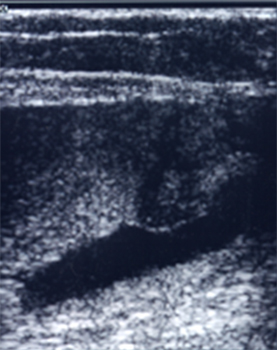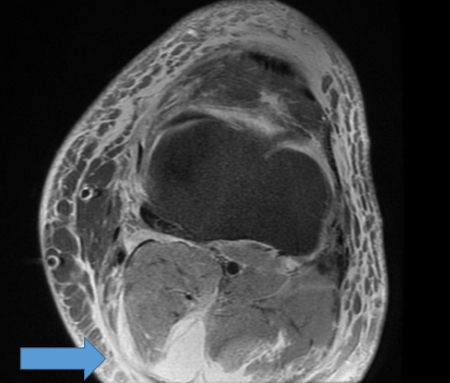Complications
Chronic pain and swelling of the knee may result from underlying knee pathology or local compression from the cyst.
May be caused by external compression of the popliteal artery.[30]
Also known as pseudothrombophlebitis syndrome. Occurs as a result of increased pressure in the bursa, which leads to rupture of the cyst and leakage of synovial fluid. [Figure caption and citation for the preceding image starts]: A ruptured haemorrhagic popliteal cyst extending in the calfStony Brook University Medical Center private collection; used with permission [Citation ends]. [Figure caption and citation for the preceding image starts]: Ruptured popliteal cyst dissection into gastrocnemiusFrom the collection of Dr John D. Kelly IV; used with permission [Citation ends].
[Figure caption and citation for the preceding image starts]: Ruptured popliteal cyst dissection into gastrocnemiusFrom the collection of Dr John D. Kelly IV; used with permission [Citation ends].
This condition mimics the presentation of DVT. If misdiagnosed, treatment with anticoagulation can be catastrophic and lead to compartment syndrome.[31]
Occurs when the cyst bursts, causing joint synovial fluid to dissect into the posterior calf muscles, causing swelling.
If the pressure on the posterior muscle increases significantly, patients develop signs and symptoms of compartment syndrome, which is a surgical emergency.[32]
Compartment syndrome is a rare complication.
Popliteal cyst may be associated with septic arthritis, particularly in the presence of osteoarthritis.[33] Although the likelihood of this occurrence is low, it can make the treatment of septic arthritis more difficult because the cyst may need to be evacuated in addition to undertaking joint lavage. Purulent fluid may nestle in the cyst and require direct drainage for infection eradication.
Use of this content is subject to our disclaimer